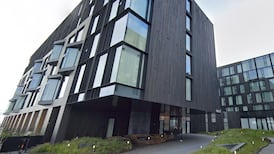The League of Ireland has found its voice. Sustained attendances at grounds across the country deliver a clear message that domestic soccer retains a central role in Irish life.
“Covid, in a bizarre way, has helped us capture a bigger audience,” Ciarán Medlar, the Shamrock Rovers chairman recently told The Irish Times.
“During Covid, people didn’t travel. They were able to go to local games before they travel again.
“People liked what that saw. We’ve sold 4,000 season tickets and other clubs are hitting record sales, so the interest is there in our league. The quality has got better because, post-Brexit, players are staying longer in Ireland and actually getting to a higher level before they move on.”
There has been a 29 per cent increase in attendances, with an extra 110,660 people going to Premier Division matches since 2019, as 486,365 showed up in 2022.
The weekly average jumped from 10,436 pre-pandemic to 13,510 last year, feeding the Medlar theory that people prefer Friday nights in Tallaght Stadium, Richmond, Tolka and Dalymount Parks than day-trips over to Anfield and Old Trafford.
The upward trend continues this season as, across the first three Friday nights, 59,320 attended 15 matches for a weekly average of 19,774.
Clearly, punters are taking the opportunity to witness teenagers like Sam Curtis in Inchicore and James McManus in Phibsborough (no sign of Justin Ferizaj or Adam Murphy yet) as Irish football inadvertently basks in the Brexit blockade of under 18s moving to English or Scottish clubs.
Or people simply want to support their local team.
The increase in crowds shines light on how supply is failing to meet demand due to a chronic underinvestment in stadiums.
“We’re trying to get investment and are putting the final touches to our facilities plan,” said Mark Scanlon, the League of Ireland director in January. “Hopefully we’ll have significant improvements but unfortunately these things take time. We’ve done a lot administratively through consultation.”
Translate “we’ve done a lot administratively through consultation” into Hiberno-English, and it reads: the FAI needs Government and private investment. Lots of it.
But the football fans have, repeatedly, delivered their end of the bargain. Increased numbers are evident across the island as Drogheda United, Cobh Ramblers, Finn Harps, Sligo Rovers, Treaty United, Waterford and Wexford can boast larger crowds with Cork City going from an average of 2,505 in 2019 to Turners’ Cross holding 5,672 since the club returned to the top flight.
Meanwhile, Munster Rugby season tickets dropped from 8,500 in 2019/20 to approximately 7,500 in 2023 although the visit of Toulouse (21,884) or Leinster (25,600) spikes Thomond Park numbers four or five times a year.
Leinster Rugby banks on at least three 40,000-plus crowds in the Aviva Stadium every season. Comparing the 15,000 average attendance at the RDS (which includes 12,248 season ticket holders) to the 12,000 seeking to fill two of the four Dublin football grounds every Friday, and it is easy to imagine upgraded stadiums ensuring that domestic football revenues dwarf the rugby neighbours.
By the way, the GAA banked €33.4 million in gate receipts last year, a drop of €2.7 million from 2019, which is explained by the Dublin-Kerry final from four years ago requiring a replay.
“In Ireland, it is not like the football fans are different from the GAA and rugby fans,” said Medlar. “They are the same people. They just go to different games. Most of us cross a lot of different sports so it is about trying to get those people to come to the games.”
The question is how many of the 15,990 RDS crowd for Leinster v Ulster in December were among the 7,626 in Tallaght last Friday to see Derry City beat Rovers, before journeying north to Celtic Park, where 12,000 caught Derry toppling Dublin in a thriller. Answers on a postcard.
Only Dundalk, at their Oriel Park eyesore, suffered a two per cent drop in crowds from 2019 to 2022, but that has slightly increased this year.
The Dublin venues, however, are trending upwards. Shelbourne made an attendance leap of 63 per cent, following promotion, and despite Tolka Park being in the state that it is, close to 3,000 keep showing up for Damien Duff’s side.
The four professional Dublin clubs attendances will rise when Rovers and South Dublin County Council increase Tallaght’s capacity to 10,500 in July.
Dalymount’s redevelopment has the firm backing of Dublin City Council but Bohs capacity is stranded at 4,500 for the foreseeable future, which fails to cater for a remarkable demand.
Some 4,114 braved a dreary Monday night for the 3-1 defeat of Drogheda United while Rovers only dropped from 7,626 last Friday to 4,028 for the 4-4 draw with Cork City three days later.
Bohs demand climbs to 7,000 fans but instead they must turn people away. The same appears to be happening with St Pat’s and Shels, who are negotiating the repurchase of Tolka Park from Dublin City Council and plans for a retro refit, which goes against arrangements Rovers and Bohs have struck with local government.
“There doesn’t need to be one stadium for everyone in the audience,” said DCC chief Dick Shakespeare, before the former FAI board member ruled out supporting the redevelopment of two stadiums on Dublin’s northside.
“We’ll have a nice tidy stadium at Dalymount. I’ve always been of the view that 8,000 stuffed to the rafters turns tickets into currency. If you build it, they will come.”
They are already coming, in their droves. Local TDs will not be long following, decked out in club colours, promising investment in stadia in exchange for votes at the next election.















